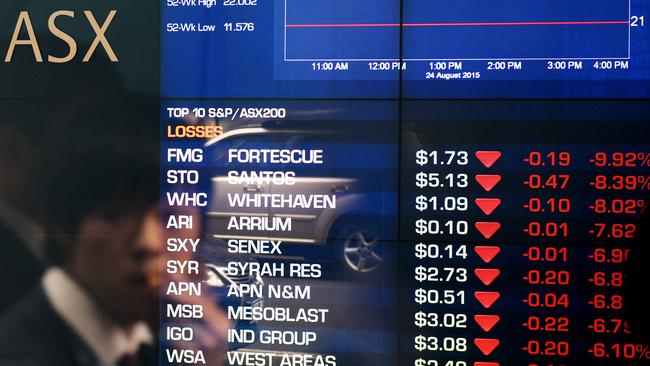Where to next in the market chaos?
THERE is panic around the world as China’s ‘Black Monday’ gets blacker. Saul Eslake explains exactly how it came to this — and where to next.
IT’S BEEN a turbulent period on global financial markets, with share prices down by around 10 per cent, on average, in New York, Tokyo and London since this time last week, and here in Australia some $60 billion wiped off the value of local stocks.
The first trigger for this ‘correction’, as it’s now widely being called, seems to have been the decision taken two weeks ago by China’s central bank to change the way in which it sets the daily trading range for China’s currency, the yuan.
Although this was a small step towards allowing ‘market forces’, rather than bureaucrats, to determine the value of the yuan — something which Western governments have been urging on China for years — the move has been widely interpreted as an attempt by China to ‘devalue’ the yuan in order to shore up its slowing economy. That’s despite the fact that, since then, China’s currency has fallen by just 3 per cent against the US dollar (slightly less than the Australian dollar has over the same period).
A second trigger came on Friday in the form of a weaker-than-expected reading on the level of activity in China’s manufacturing sector this month. Again, this was hardly ‘news’ — and this particular survey hasn’t been an especially reliable ‘leading indicator’ of broader trends in the Chinese economy in recent years.
But taken together with the sharp decline in the Chinese share market since early June, in the face of aggressive but ultimately unsuccessful efforts by the Chinese authorities to stabilise it, these developments appear to have prompted a substantial loss of confidence in the near-term outlook for the Chinese economy.
That China’s economy is slowing is not in dispute: it’s been well-known for a long time. But investors (and others) have typically remained confident that this slowdown would be orderly and well-managed, and would pose few if any threats to the stability of the world economy or the global financial system.
Now, that confidence is being challenged. And it matters, because China is now the world’s second largest economy, and not far off becoming the largest. China’s economy has been the most important contributor to growth in the global economy since the onset of the global financial crisis, from which the recovery in so-called ‘advanced’ economies has been slow and erratic. China’s economy has continued growing while other large ‘emerging’ economies, such as Russia and Brazil, have fallen into recession. And of course China is Australia’s most important trading partner, not only because it takes almost one-third of our exports, but also because it in effect sets the prices we get for many of our exports to other countries.

Clearly, the Chinese authorities’ efforts to put a floor under their stock market haven’t worked. And that seems to have undermined global investors’ confidence in their ability to deal with potential (or actual) threats to the broader Chinese economy.
Whether that loss of faith is justified remains to be seen. Without doubt, China has much less scope to use monetary policy to support economic growth than at the time of the global financial crisis. But it still has plenty of room to deploy fiscal policy (infrastructure spending and the like) should the need arise. And the growth in China’s services sector means that a downturn in manufacturing represents less of a drag on the overall economy than it did seven years ago.
Another factor which may be contributing to the upheavals in global financial markets is the belated recognition that the era of zero interest rates is coming to an end, at least in the United States. The US central bank’s ‘unorthodox’ monetary policy played a vital role in stabilising global financial markets during the crisis, and in nurturing a fragile economic recovery since then.
But it has also fostered an appetite for risk in financial markets which, if left unchecked for too long, could sow the seeds of another financial crisis. The US stock market, in particular, had reached record highs earlier this year despite an indifferent outlook for corporate profits, and various forms of risky borrowing and lending — including across international borders — have increased significantly in recent years.
Yet despite repeated indications that the Federal Reserve has been edging closer to raising US interest rates for the first time since 2006, financial markets have persisted in assigning very low probabilities to such a move.
Some will no doubt argue that the sharp falls in global stock markets over the past week constitute another reason why the US Federal Reserve should keep interest rates at zero for yet longer. In my view, however, unless there are clear signs of a renewed downturn in the US economy — in contrast to the recent run of US economic data — that would ultimately carry even greater risks. A signal that the US economy is sufficiently well placed that it no longer requires zero interest rates should be seen as building confidence, not undermining it.
Likewise here in Australia, while we need to pay close attention to developments in China and our other important trading partners, panic is not in order. As the RBA observed in its most recent monetary policy statement, the Australian economy has been doing a little better in many respects than had been expected three and six months ago. It doesn’t need to cut rates again. The currency is doing that work for it.
Saul Eslake is former chief economist at ANZ and Bank of America Merrill Lynch Australia.



